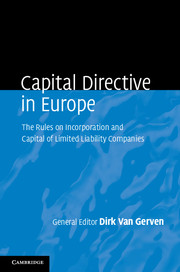1 - Community rules applicable to the incorporation and capital of public limited liability companies
from Part I
Published online by Cambridge University Press: 05 June 2014
Summary
Introduction
Clear and similar rules on the incorporation and capital of limited liability companies are necessary in order to ensure easy cross-border cooperation between companies and individuals established in different Member States. Creditors of these companies need to know how the debtor's property, i.e., the company's capital, is protected and can be used. For these reasons the Community legislature coordinated the rules applicable to the incorporation and capital of public limited liability companies in 1976. These rules were laid down in Second Council Directive 77/91/EEC of 13 December 1976 on coordination of safeguards which, for the protection of the interests of members and others, are required by Member States of companies within the meaning of the second paragraph of Article 58 of the Treaty, in respect of the formation of public limited liability companies and the maintenance and alteration of their capital, with a view to making such safeguards equivalent (the “Second Company Law Directive”). This directive was later amended by Council Directive 92/101/EEC of 23 November 1992.
Initially, the coordination was restricted to public limited liability companies, as these are most likely to operate cross border. However, several Member States extended these rules to all or most types of national corporate forms with limited liability for shareholders, i.e., the liability of shareholders for obligations of the company is limited to their capital contributions.
- Type
- Chapter
- Information
- Capital Directive in EuropeThe Rules on Incorporation and Capital of Limited Liability Companies, pp. 3 - 52Publisher: Cambridge University PressPrint publication year: 2014
References
- 1
- Cited by



